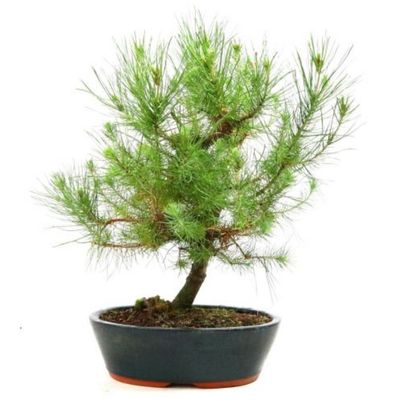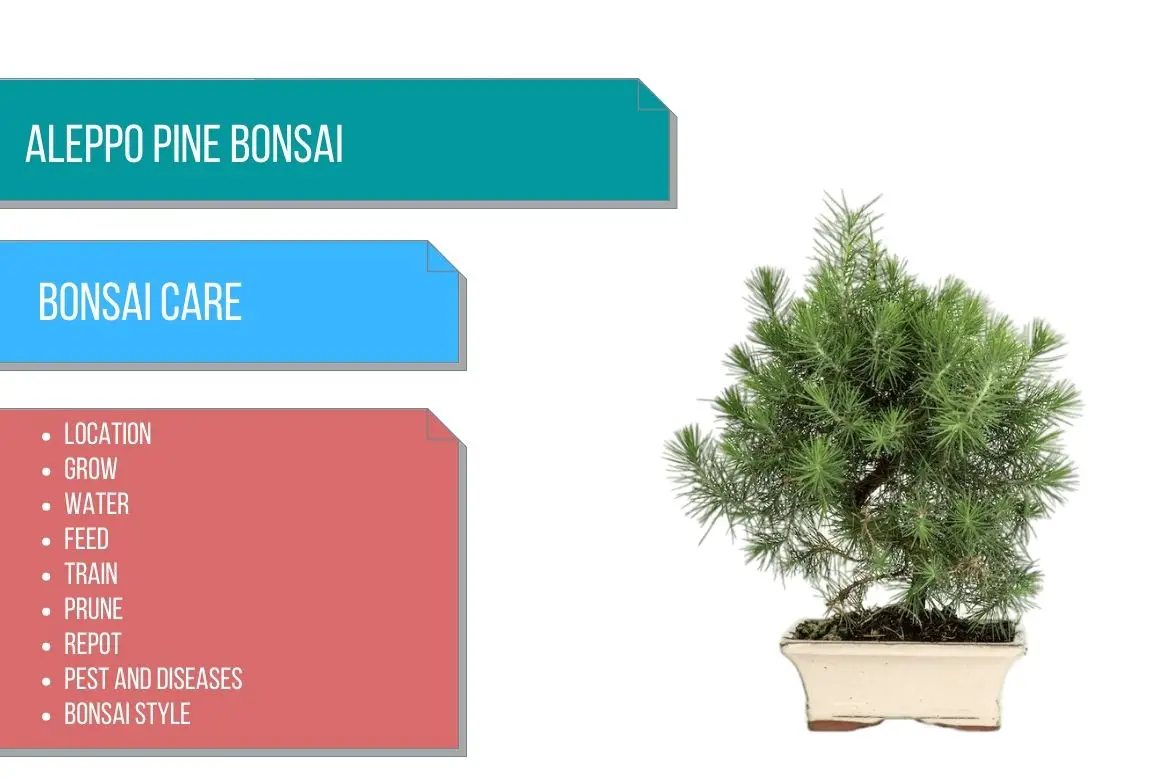
Aleppo pine
( Pinus halepensis )
Country of Origin : Mediterranean
Bonsai Styles : Formal upright, Informal upright, group, root over rock, slanting, semi-cascade, Literati
Zone : 8 – 11
The Aleppo pine also known as Jerusalem pine is an evergreen conifer.
A young tree has grayish and smooth bark. However, a mature Aleppo pine bonsai tree develops a reddish-brown trunk with typical pine-like bark. Also, the trunk attains a furrowed texture as the tree ages.
This tree does not flower. The needles of the tree are soft and light green in color and are arranged in pairs on the branches.
The branches of the tree growing with prominent turns and twists collectively produce a somewhat thin canopy.
It is a low maintenance tree and is one of the suitable varieties to make an indoor bonsai tree.
While the needles of the Aleppo pine tree can reach a length of up to 10 cm in the wild, they are usually less than 2 cm in length when trained as a bonsai.
The growth pattern of the tree can be echoed in all styles, except for the broom style. It is easy to train P. halepensis to grow in an upright bonsai style.
In older specimens, the needles become relatively long, so the final bonsai height should be at least 12 inches (30cm).
Read more about other pine tree bonsai in : Types of bonsai trees .
Best location to keep Aleppo pine Bonsai
Aleppo pine bonsai trees prefer bright, sunny spots.
It is easier to maintain a Pinus halepensis bonsai if it is shaded from the midday sun, since it would otherwise have to be watered frequently.
It should be outside between May and September, either in the garden or on a balcony.
When it is winter, it should be kept in a cold conservatory, an unheated room indoors with an occasional window open, or in a frost-free greenhouse.
The tree can be kept indoors throughout the winter at a temperature of not less than 41°F (5°C).
The ideal temperature is between 50°F (10°C) and 68°F (20°C). It is important to maintain a humidity level of at least 50%.
Protect the tree from the wind.
IMP: Refer sunlight requirements for indoor plants for more indoor gardening ideas. Also, refer to do bonsai trees need sunlight for more indoor and outdoor bonsai location ideas.
Propagation of Aleppo pine
Aleppo pine can be grown from seeds in late winter.
Soak the seeds in water for 1-2 days. Keep the seeds in moist peat moss and Cold stratify the seeds in the fridge for about 2-3 months. (This step is optional and usually done to increase the chances of germination. you can directly sow the seeds also)
Plant the seeds in a seeding tray. With in 10 days you should see germination.
There is no need to apple rooting hormone. Keep your stem cutting at a warm place but not under direct sunlight. The rooting should occur within a month.
U can also use stem cuttings to propagate Aleppo pine. However, while doing so, you will have to take care of few things.
Take stem cuttings from upper shoots, since these shoots display vigorous growth. Take the cuttings of length 15 – 18 cm.
Apply some rooting hormone to the stem and plant it. Rooting will occur in almost 3 months. Read this research paper for a detailed procedure.
Watering Aleppo pine Bonsai
You should keep your young bonsai specimens evenly moist, but not too wet.
However, older bonsai specimens can survive brief periods of dryness, although young shoots will become shriveled.
Water the bonsai tree when the soil feels dry to the touch.
The plant is very adaptable to changes in watering, but only if the changes are made over a long period of time. It may be damaged or even killed by sudden changes in watering frequency.
You can even use hard tap water for this tree.
Read watering bonsai tree for more details.
Wiring Aleppo pine Bonsai
It is possible to do wiring at any time of the year.
It is possible to shape even three-year-old branches with wire because the branches remain flexible for a long time.
Wires need to be checked regularly: at certain times, the branches thicken quickly, resulting in a risk of damage to the bark if the wire becomes too tight.
The wires must be removed and, usually, replaced if this happens.
Wired sections of the tree should have their needles removed, as they turn brown and become unsightly quickly.
Pruning Aleppo pine Bonsai
When to prune Aleppo pine bonsai?
How to prune Aleppo pine bonsai?
When trained as a bonsai, it does not produce candles in the spring, unlike other pines. You can see tiny buds in the axils of the needles at irregular intervals along new growth, if you look closely.
You can carefully prune either by pruning above one of these buds, or by pinching it out.
Regularly do this to prevent long needles from developing on the tree.
It is best to cut back new growth on young plants after they reach a length of 15-20cm (6-8 in).
You should prune the top shoots of the tree harder than the lower ones.
Repotting Aleppo pine Bonsai
When to repot Aleppo pine bonsai?
Every 2 to 3 years, the Aleppo pine bonsai tree can be repotted. Spring is a good time to repot the tree.
It is important to inspect the roots at yearly intervals during the slower growth period of this variety, as they can grow thick roots quickly.
You can even prune roots of the tree. It is recommended to change two-thirds of the soil every two to three years, along with pruning the roots.
Give the tree some bottom heat after repotting to encourage new root growth.
You can use a basic free-draining, bonsai soil mix as a potting soil.
Or you can use a mixture of lava chippings, sand and fired clay particles at a ratio of 1:1:2.
Must Read: Bonsai Soil Recipes
Must read : Choosing the right bonsai container
Feeding Aleppo pine Bonsai
An organic or inorganic fertilizer should be applied every two weeks to young Aleppo bonsai trees, and every month to older ones.
During the winter months, this should be reduced unless the tree is kept very warm.
Read more about bonsai fertilizer and its application.
Diseases and pest of Aleppo pine Bonsai
These trees in bonsai containers are generally pest free.
Aleppo pine bonsai care
If the needles of the tree are turning yellow, then its a sign of over watering or poor drainage.

